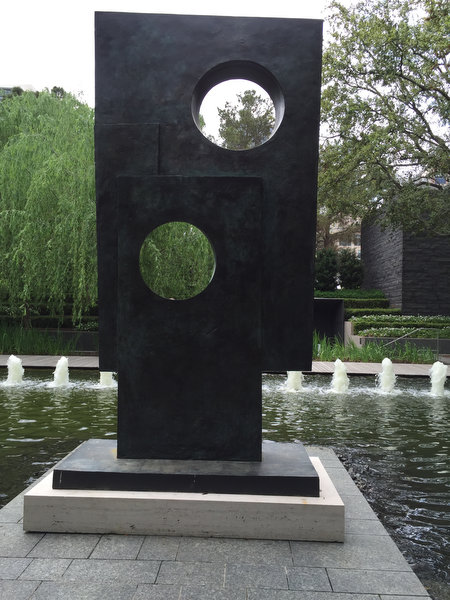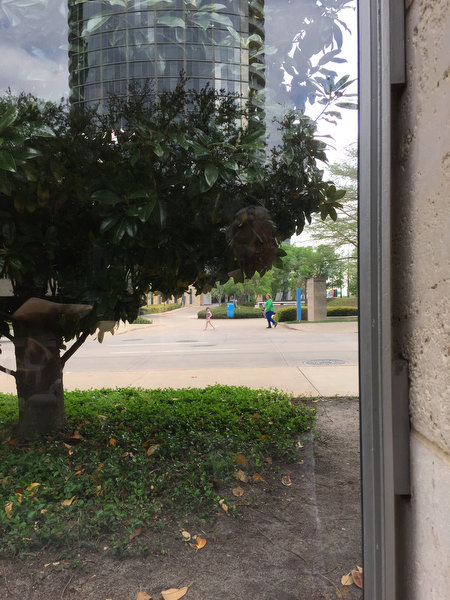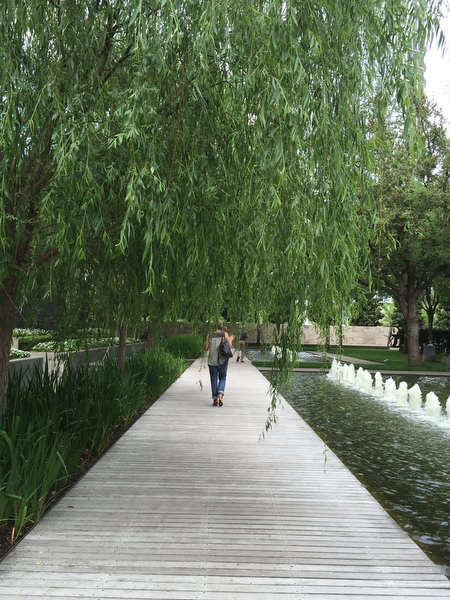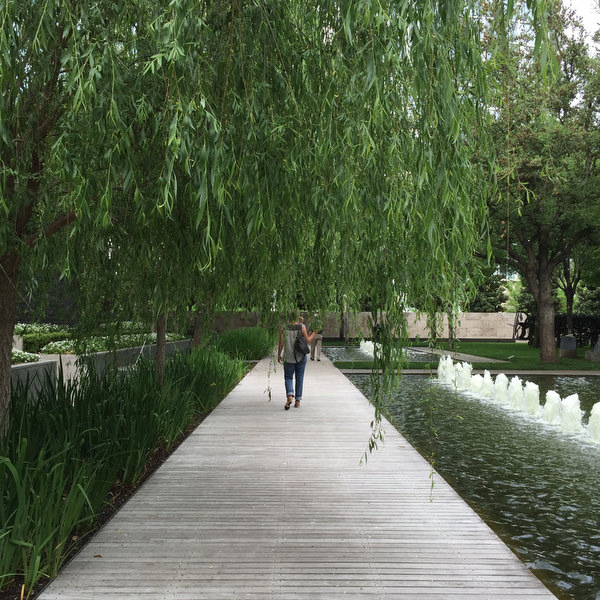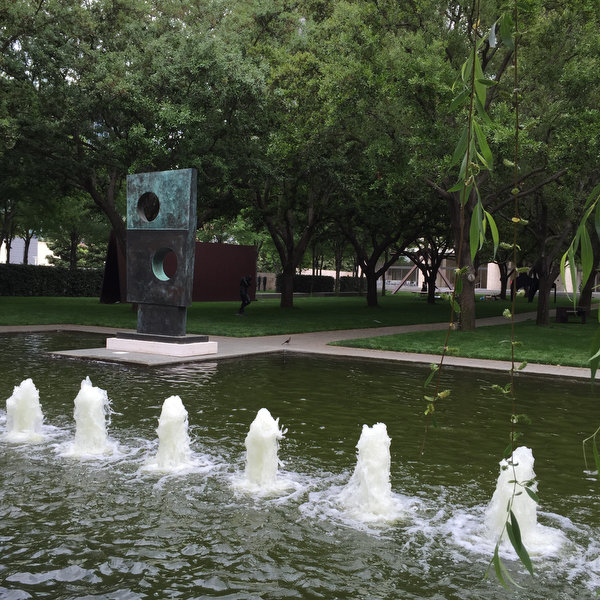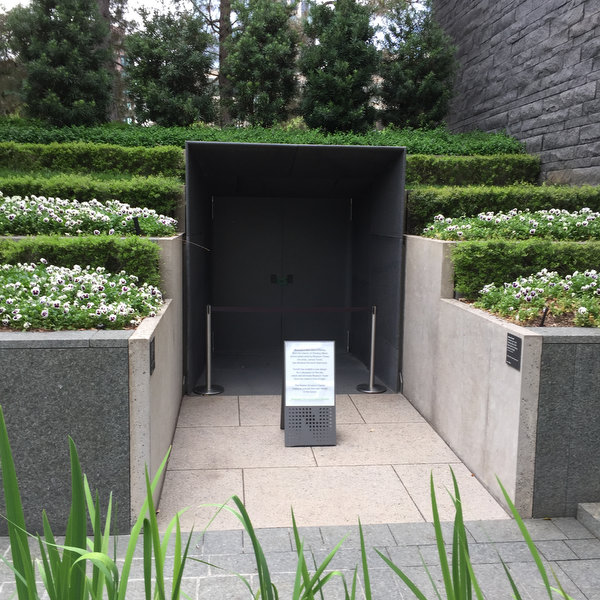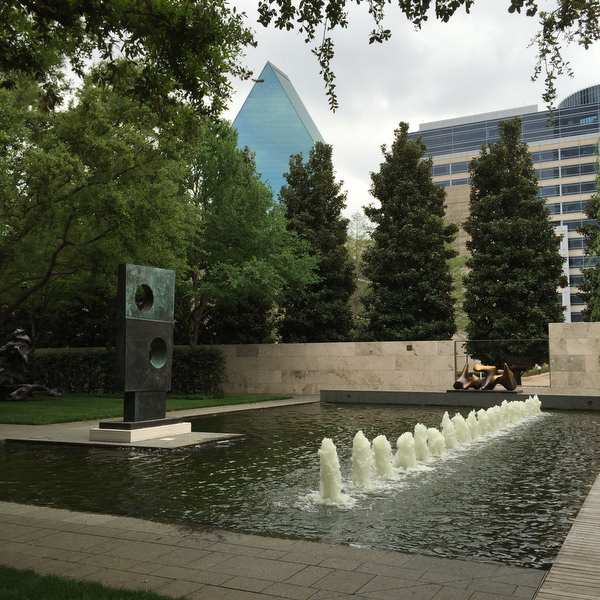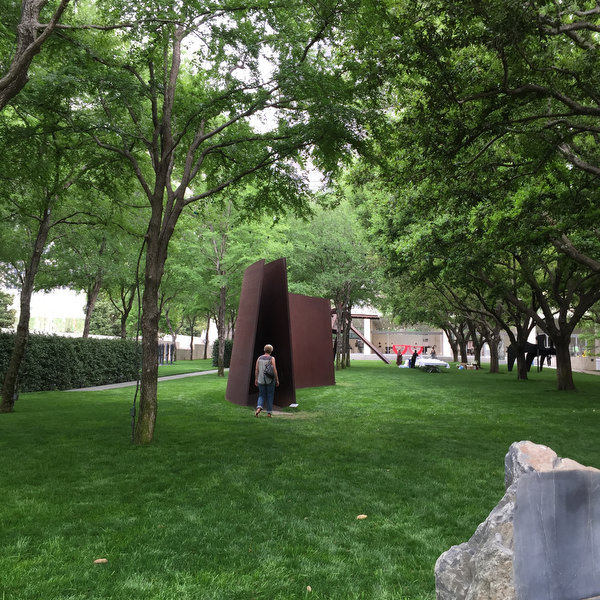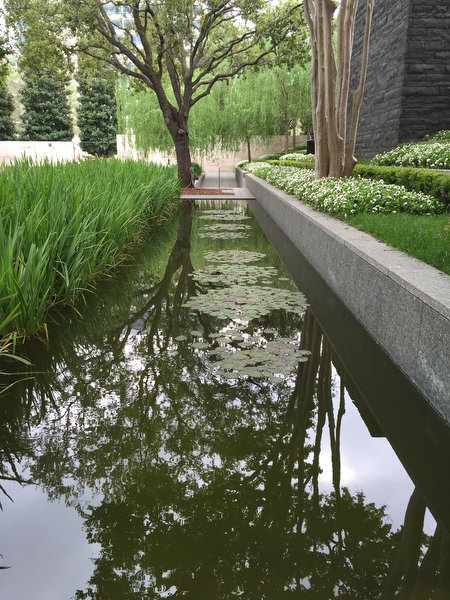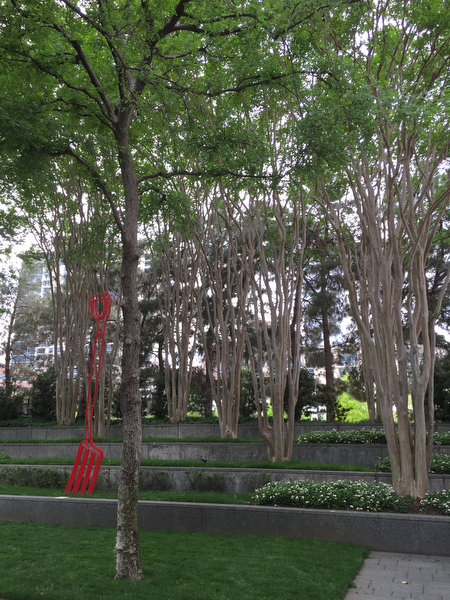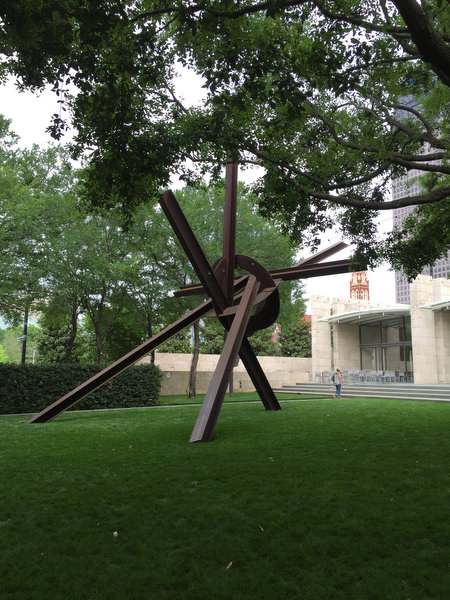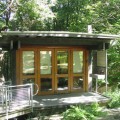A sense of calm fell over me as I descended into the garden at the Nasher Sculpture Center in Dallas. Sculpture isn’t usually my thing — not sure why, I guess I just haven’t studied it enough to appreciate it.
But gardens are my thing. And when big, beautiful, thought-provoking art is part of a garden, well. That’s something else, isn’t it.
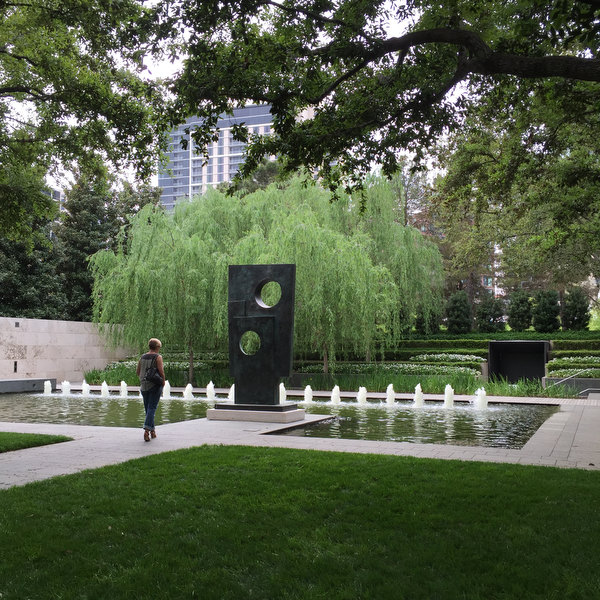
It was just 15 minutes or so before closing, and when we walked through the thick glass doors to enter, the person behind the limestone ticket station just waved us on through. We were thankful. And we wished we’d had more time.
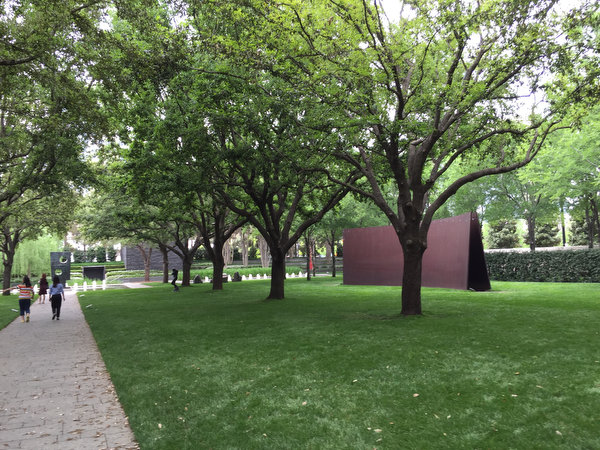
It’s hard to say what takes your eye first. The alley of trees. The pathway to the water. The Richard Serra metal teepee. The Alexander Calder sculpture “Three Bollards (Trois Bollards),” 1970.
Maybe the Calder.
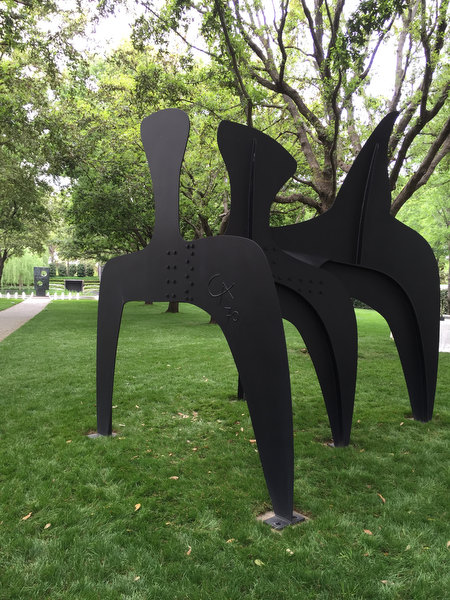
From the web site:
“Three Bollards (Trois Bollards),” 1970. Painted steel, 137 x 114 x 137 in. (348 x 289.6 x 348 cm.)
Raymond and Patsy Nasher Collection, Nasher Sculpture Center, Dallas, Texas
Calder’s first stabiles – standing, non-kinetic works – date from the 1930s and translate into three-dimensional form the lyrical, biomorphic shapes he loved in the paintings and collages of Joan Miró and Jean Arp. Cut from sheet metal, assembled with rivets or bolts, and frequently painted black, these works reflect Calder’s training as an engineer and his interest in technological processes of construction. Three Bollards typifies this genre in its large scale and flat, semi-biological, semi-geometric shapes. It humorously suggests a large animal or sea creature and invites viewers to experience its spatial complexities by walking around and through it. Its title derives from the three knobby protrusions at the top, seen in conjunction with the longer pointed “tail,” which resemble bollards, posts for tying up boats at dock.
To feel movement in a massive piece of metal is astonishing.
I love the juxtaposition of the Rodin and the Serra here. The delicate curves of a woman — Eve, no less — alongside the imposing yet accessible curve of steel.
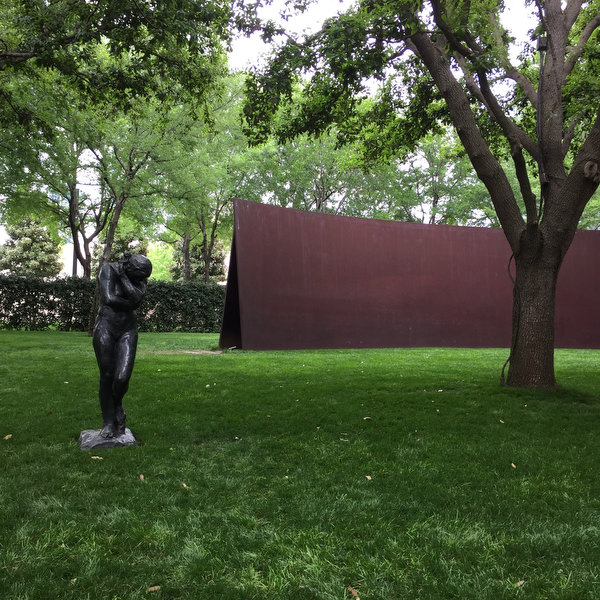
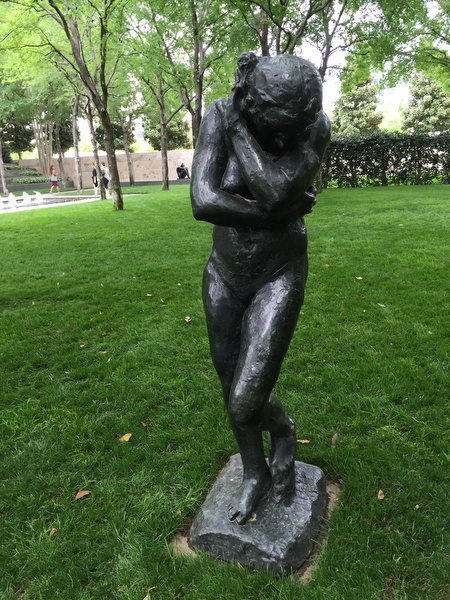
Eve, 1881 (cast before 1932)
Bronze, 68 x 17 1/4 x 25 1/2 in. (172.7 x 43.8 x 64.8 cm.)
Raymond and Patsy Nasher Collection, Nasher Sculpture Center, Dallas, Texas
Eve provides an outstanding example of the personal, expressive nature of Rodin’s modeling. Certain areas of the surface are treated smoothly with the utmost naturalism and a sure knowledge of the body’s underlying structure. Other sections are given a rough, improvisational quality, creating dynamic plays of light and texture. Particularly striking are the distortions to the left hand and summary definition of face and hair. Rodin drew inspiration for his figure from Michelangelo’s Eve in the Sistine Chapel frescoes. Beyond the obvious biblical connotations of the anguish of original sin, the sculpture strikes a broader metaphorical note, conveying the spiritual or psychological malaise that many authors of the time considered characteristic of modern life.
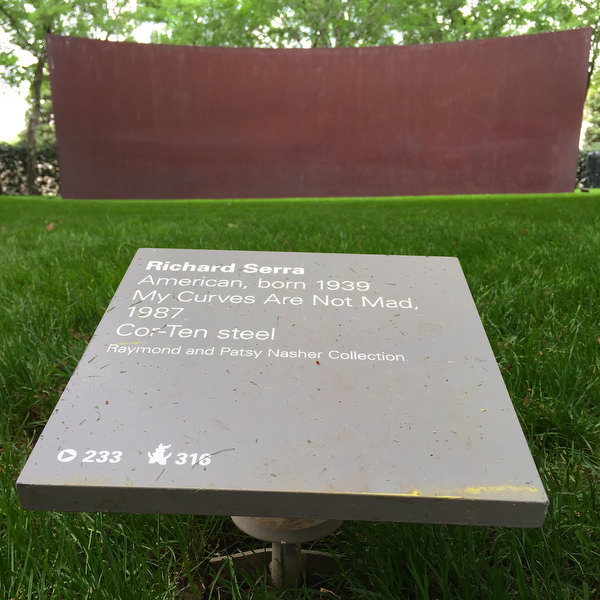
Richard Serra
My Curves Are Not Mad, 1987
Cor-Ten Steel, Overall: 168 x 539 3/8 x 139 in. (426.7 x 1370 x 353.1 cm.)Each plate: 168 x 539 3/8 x 2 in. (426.7 x 1370 x 5.1 cm.)
Raymond and Patsy Nasher Collection, Nasher Sculpture Center, Dallas, Texas
Serra’s monumental works emphasize concepts fundamental to sculpture: mass and form, material and process, site and context. My Curves Are Not Mad is an overwhelming physical presence: each plate is forty-four feet long, fourteen feet tall, and weighs over fifty thousand pounds. Its curves seem to lean precariously and carve out unexpected shifts in volume and depth, making the experience of walking between the plates a bit unsettling. The warm, reddish-brown tone and soft texture of the weathered Cor-Ten steel make the work as visually stunning as it is physically imposing. At such a large scale, the sculpture defines space and transforms its surroundings. A particular irony results from the installation here: the natural forms of the garden are quite orderly in their rectilinear arrangement, while the hard, industrial material of the sculpture curves organically.
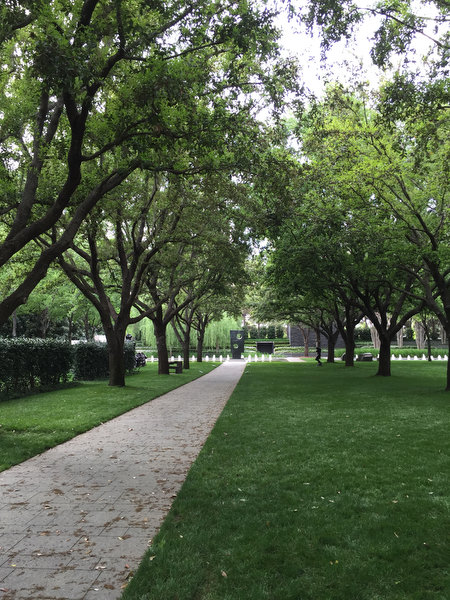
This smallish (comparatively speaking, of course) piece is like a beacon to visitors, pulling them along the pathway toward the water.
Barbara Hepworth
Squares with Two Circles (Monolith), 1963 (cast 1964)
Bronze, 124 x 65 x 30 in. (315 x 165.1 x 76.2 cm.)
Raymond and Patsy Nasher Collection, Nasher Sculpture Center, Dallas, Texas
When Patsy and Raymond Nasher purchased this work in 1968, it was one of their earliest acquisitions in the realm of modern sculpture. Influenced by the timeless power of Neolithic stone monuments, Hepworth adopted the form of an upright slab. The distinctive hollowed out circles, a device the artist had used in her work as early as the 1930s, open up the solid mass and allow a continuous flow of space through and around the monolith. With the round apertures framing the surrounding landscape and the richly varied green patina of the bronze, the overall effect of the sculpture is one of natural forms and forces.
Here is a little of my own art. Out the glass window surrounding the garden: a tree, an outline of a skyscraper and a mother walking after her bathing-suit clad little girl. In downtown Dallas.
You can walk on water int he garden, as Sarah is doing in front of me here.
I let the leaves of the willow wash over me, cling to my hair, tickle my shoulders, as I walked through them.
The sounds are very few. Bubbling. Whistling. Splashing.
A controversial skyscraper called Museum Tower has changed the shadows and reflections onto the center and the garden. Afterwards, the artist James Turrell declared his work destroyed.
The placard reads:
“Because a clear view of the sky from the interior of “Tending (Blue)” is now obstructed by Museum Tower, the artist, James Turrell, has declared the work destroyed.”
More from the peaceful place:
Crepe myrtles with red fork:
We’ll end on this impressive and stunning piece:
From the website:
Mark di Suvero
Eviva Amore, 2001
Steel, Overall: 424 x 564 x 360 in., 22500 lb. (1077 x 1432.6 x 914.4cm, 10205.9kg)Other (I-beam 6): 18 5/8 x 11 3/16 x 180 in., 1300 lb. (47.3 x 28.4 x 457.2cm, 589.7kg)Other (I-beam 7): 12 x 12 x 346 in., 2300lb. (30.5 x 30.5 x 878.8cm, 1043.3kg)Other (I-beam 8): 12 x 12 x 276in., 1800lb. (30.5 x 30.5 x 701cm, 816.5kg)Other (Joint with arcs): 120 x 120in., 7800lb. (304.8 x 304.8cm, 3538.1kg)
Raymond and Patsy Nasher Collection, Nasher Sculpture Center, Dallas, Texas
Mark di Suvero’s monumental steel sculptures expand to architectural scale the constructivist explorations begun by Pablo Picasso, Julio González, and David Smith in the first half of the 20th century. With beams thrusting outward from a central core, Eviva Amore (Long Live Love) is an exclamation of passion in raw, weathered steel. The 22,000 pound structure spans 47 feet. Welded and bolted together, its carefully balanced, cantilevered elements give the sculpture both an industrial quality and elegant grace. Other examples of di Suvero’s work in Dallas include In the Bushes, also at the Nasher Sculpture Center, Ave at the Dallas Museum of Art, and Proverb, on loan from the artist to the Meyerson Symphony Center and visible from our terrace.


